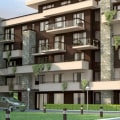Residential buildings, designed primarily for living purposes, exhibit certain distinct characteristics. They typically include living spaces such as bedrooms, bathrooms, a kitchen, and a living room. Comfort, privacy, and functionality are key elements in their design, with an emphasis on creating a welcoming and habitable environment. Safety features, such as smoke detectors and secure locks, are integral. Additionally, residential buildings require regular maintenance to keep them in good condition. For instance, the roof is a critical component, and homeowners often rely on Raleigh roof repair companies for upkeep. These companies specialize in ensuring the roof, a crucial protective feature of any residential building, remains in optimal condition to protect against weather elements.
An aesthetically pleasing and architecturally beautiful construction is a necessity. This page provides annual national data on the characteristics of new privately owned residential structures, such as square footage, the number of bedrooms and bathrooms, the type of wall material, and sales prices. There are many features available at the region level. The data comes from the Construction Survey (SOC), which is partially funded by the Department of Housing and Urban Development (HUD).
These walkways are often anonymous public spaces with little evidence of social control or residential ownership. The characteristics of the external built residential environment include aspects of building design, such as the types of walls, doors and windows, green spaces, the density of houses per unit of area, and waste disposal facilities. The lack of commercial establishments in high-income residential areas was significantly associated with the onset of depression, even though residents could buy food in large quantities and refrigerate it. On the other hand, the internal built residential environment refers to the artificial components of the interior locations of housing units.
Here is an overview of what are the 9 qualities you can expect from a good design for a residential project that may affect the long-term operations of your housing project. As for women, 95 were from low-income residential areas, 87 were from middle income residential areas and 88 were residents of high-income residential areas. Since low-income residential areas were primarily affected by a lack of physical planning and inadequate amenities, residents who lived there were more likely to suffer from several mental health disorders identified in this study. The results show that the wall materials used in buildings, the density of housing units, the state of street lighting, the types of doors, the condition of the roofs and the condition of the windows are some of the characteristics of the built external residential environment that affect the mental health of adult men and women.
A total of 544 respondents from the respective residential areas representing low-, middle- and high-income neighborhoods were selected through a multi-stage random sampling process. Urban residential areas that are characterized by a poor quality external built environment substantially expose the population to daily stress factors and inconveniences that increase the likelihood of developing mental health disorders. Along with garbage from commercial establishments, which was due to shoppers carelessly discarding packaging such as polyethylene paper bags, broken garbage bags helped unsightly garbage to spread around malls and markets in middle income residential areas. Overall, 185 respondents came from low-income areas, 183 from middle income areas, and 176 were from high-income residential areas.
However, there was no significant difference in levels of panic disorder between low- and high-income residential areas (x2 %3D 0.269, P %3D 0.60). Both of these situations create panic, as privacy or personal safety are not guaranteed, especially in crowded residential areas. While many of the residents of low-income neighborhoods are renters, some of those who live in middle income residential areas and most people in high-income areas have built their own homes. .



